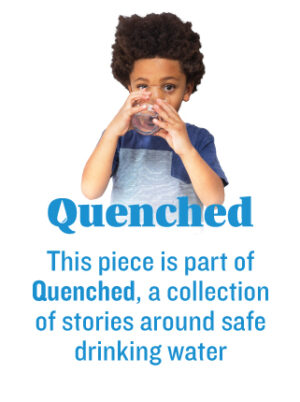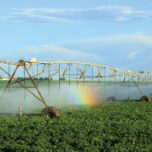March 18, 2013 —  In tiny Seville, Calif., the snow-capped Sierra Nevada mountains rise like a mural behind neat rows of dark-leafed trees studded with bright oranges. The trees rustle as hidden farmworkers pick the ripe fruit. Farming in the fertile Central Valley is worth $17 billion annually and yields nearly half the nation’s fruits, nuts and vegetables. But there’s a high price: Thanks to modern agriculture, the farmworkers who live here can’t drink their own tap water. While pollutants vary, one of the most troublesome is nitrate, a component of nitrogen fertilizer used on these crops that makes the water unfit for human consumption.
In tiny Seville, Calif., the snow-capped Sierra Nevada mountains rise like a mural behind neat rows of dark-leafed trees studded with bright oranges. The trees rustle as hidden farmworkers pick the ripe fruit. Farming in the fertile Central Valley is worth $17 billion annually and yields nearly half the nation’s fruits, nuts and vegetables. But there’s a high price: Thanks to modern agriculture, the farmworkers who live here can’t drink their own tap water. While pollutants vary, one of the most troublesome is nitrate, a component of nitrogen fertilizer used on these crops that makes the water unfit for human consumption.
That this and hundreds of other communities do not have access to safe drinking water — in one of the richest countries in the world — shocked the U.N. special rapporteur on the human right to safe drinking water and sanitation, Catarina de Albuquerque, when she visited Seville and other San Joaquin Valley communities in 2011.
“Nitrate in groundwater is the most significant water quality problem in the nation” —California State Water Resources Control Board
Nitrates in groundwater have become a big problem in many rural communities across the U.S. because, thanks to a powerful agricultural lobby, the federal Clean Water Act exempts virtually all agricultural runoff from regulation. Also, nitrates are increasing in groundwater at the same time that our dependence on groundwater is growing, which could lead to higher costs to treat municipal drinking water.
“Nitrate in groundwater is the most significant water quality problem in the nation, and … commercial fertilizer is the primary source of loading,” concluded a 2011 report from the California State Water Resources Control Board, citing a large body of data. But California is now doing something about that. Last fall, Gov. Jerry Brown made it state policy that every Californian has a right to safe, clean, affordable, accessible drinking water.
“That policy makes a public commitment and also directs state agencies to recognize this issue,” says Maria Herrera, community outreach director for Community Water Center, an advocacy organization headquartered not far from Seville.
In late February 2013, the State Water Resources Control Board submitted a report to the California legislature outlining contaminants in groundwater, affected communities and suggestions to address the problem. To fund the delivery of safe drinking water, the report suggested potential taxes or fees on agricultural commodities, nitrogen fertilizer or water use.
Serious Impacts
This problem isn’t California’s alone. Though the percentage of people nationwide who have no alternative but to drink untreated water contaminated by nitrates is small, typically they are economically disadvantaged people, making this a national environmental justice issue.
Since the 1950s, the increasing industrialization of agriculture has spawned heavy use of commercial fertilizers across the United States. Because crops can’t absorb all the nitrogen fertilizer applied, some nitrates remain. When the crops are irrigated, the nitrates are often transported to surface waters or groundwater. Other sources of nitrate pollution, such as animal waste from dairy and meat production, ineffective sewage treatment plants, and septic system seepage, can exacerbate the problem.
Nitrate pollution is prevalent wherever farming and animal husbandry are intensive. Farming along the Mississippi River watershed conveys nitrates to the Gulf of Mexico, where each summer they stimulate the growth of algae that suck oxygen from the water, killing aquatic life in the aptly named Dead Zone. Chesapeake Bay algae blooms and fish kills are also caused by nutrient pollution, including nitrates. These ecosystems teeter on the brink of collapse, and seafood industries have been decimated by the pollution. Nitrate concentrations in groundwater in several Texas counties have also increased since the 1960s, according to a recent study in the Journal of Environmental Quality.
But as important as they are, environmental impacts are just part of the story. Nitrates have serious implications for human health as well. A 2010 study from the National Cancer Institute found increased risk of thyroid cancer in women associated with higher nitrate levels in public water supplies. Other studies show correlations with spleen and kidney disease and gastrointestinal problems. Perhaps the most evocative concern is blue baby syndrome, or methemoglobinemia, a condition in which infants’ blood can’t deliver enough oxygen to their tissues, causing sickness and death.
Related Posts
Ensia shares solutions-focused stories free of charge through our online magazine and partner media. That means audiences around the world have ready access to stories that can — and do — help them shape a better future. If you value our work, please show your support today.
Yes, I'll support Ensia!



